List of World Heritage Sites in Western Asia
The United Nations Educational, Scientific and Cultural Organization (UNESCO) has 71 World Heritage Sites in 16 countries of Western Asia. The countries are: Armenia, Azerbaijan, Bahrain, Cyprus, Georgia, Iran, Iraq, Israel, Jordan, Lebanon, Oman, Saudi Arabia, Syria, Turkey, United Arab Emirates and Yemen. Qatar and Kuwait, which are also in the region, do not have any World Heritage Sites.[1][2]
In this region, Iran is home to the most sites with 13 sites.[3]
Legend[change | change source]
- Site; named after the World Heritage Committee's official designation[3]
- Location; at city, regional, or provincial level and geocoordinates
- Criteria; as defined by the World Heritage Committee
- Area; in hectares and acres. If available, the size of the buffer zone has been noted as well. A value of zero implies that no data has been published by UNESCO
- Year; during which the site was added to the World Heritage List
- Description; brief information about the site, including reasons for qualifying as an endangered site, if applicable
Sites[change | change source]
† In danger
| Site | Image | Location | Criteria | Area ha (acre) |
Year | Description | Refs |
|---|---|---|---|---|---|---|---|
| Aflaj Irrigation Systems of Oman | — | Sharqiyah and Batinah Regions, 22°59′56″N 57°32′10″E / 22.99889°N 57.53611°E |
Cultural: (v) |
1,456 (3,600); buffer zone 16,404 (40,540) | 2006 | The property includes five aflaj irrigation systems. It is representative of some 3,000 such systems still in use in Oman. The origins of this system of irrigation may date back to AD 500. Archaeological evidence suggests that irrigation systems were in this very arid area as early as 2500 BC. | [4] |
| Al-Hijr Archaeological Site (Madâin Sâlih) | Al Madinah Province, 26°47′1″N 37°57′18″E / 26.78361°N 37.95500°E |
Cultural: (ii)(iii) |
1,621 (4,010); buffer zone 1,659 (4,100) | 2008 | Formerly known as Hegra it is the largest conserved site of the Nabataeans south of Petra in Jordan. It has well-preserved monumental tombs with decorated facades dating from the 1st century BC to the 1st century AD. | [5] | |
| Ancient City of Aleppo | 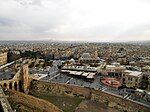
|
Aleppo Governorate, 36°14′0″N 37°10′0″E / 36.23333°N 37.16667°E |
Cultural: (iii)(iv) |
350 (860) | 1986 | Aleppo was ruled successively by the Hittites, Assyrians, Arabs, Mongols, Mamelukes and Ottomans. | [6] |
| Ancient City of Bosra | 
|
Daraa Governorate, 32°31′5″N 36°28′54″E / 32.51806°N 36.48167°E |
Cultural: (i)(iii)(vi) |
— | 1980 | Bosra, once the capital of the Roman province of Arabia, was an important stopover on the ancient caravan route to Mecca. A magnificent 2nd-century Roman theatre, early Christian ruins and several mosques are found in its great walls. | [7] |
| Ancient City of Damascus | 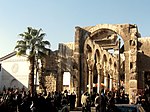
|
Damascus Governorate, 33°30′41″N 36°18′23″E / 33.51139°N 36.30639°E |
Cultural: (i)(ii)(iii)(iv)(vi) |
86 (210) | 1979 | Founded in the 3rd millennium B.C., Damascus is one of the oldest cities in the Middle East. In the Middle Ages, it was the centre of a flourishing craft industry, specializing in swords and lace. | [8] |
| Ancient Villages of Northern Syria | 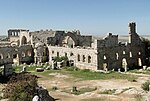
|
36°20′3″N 36°50′39″E / 36.33417°N 36.84417°E |
Cultural: (iii)(iv)(v) |
12,290 (30,400) | 2011 | Some 40 villages grouped in eight parks in north-western Syria show rural life in late Antiquity and during the Byzantine period. | [9] |
| Anjar | 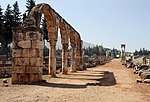
|
Beqaa Governorate, 33°43′33″N 35°55′47″E / 33.72583°N 35.92972°E |
Cultural: (iii)(iv) |
— | 1984 | The city of Anjar was founded by Caliph Walid I at the beginning of the 8th century. | [10] |
| Archaeological Site of Troy | 
|
Çanakkale Province, 39°57′23″N 26°14′20″E / 39.95639°N 26.23889°E |
Cultural: (ii)(iii)(vi) |
158 (390) | 1998 | [11] | |
| Archaeological Sites of Bat, Al-Khutm and Al-Ayn | — | Ad Dhahirah Region, 23°16′11″N 56°44′42″E / 23.26972°N 56.74500°E |
Cultural: (iii)(iv) |
— | 1988 | The protohistoric site of Bat is near a palm grove in the interior of the Sultanate of Oman. Together with the neighbouring sites, it forms the most complete collection of settlements and necropolises from the 3rd millennium B.C. in the world. | [12] |
| Armenian Monastic Ensembles of Iran | 
|
West Azerbaijan, 38°58′44″N 45°28′24″E / 38.97889°N 45.47333°E |
Cultural: (ii)(iii)(vi) |
129 (320); buffer zone 655 (1,620) | 2008 | [13] | |
| Ashur (Qal'at Sherqat) | —
|
Salah ad Din Governorate, 35°27′32″N 43°15′35″E / 35.45889°N 43.25972°E |
Cultural: (iii)(iv) |
70 (170); buffer zone 100 (250) | 2003 | The ancient city of Ashur is on the Tigris River in northern Mesopotamia. The city dates back to the 3rd millennium BC. From the 14th to the 9th centuries BC it was the first capital of the Assyrian Empire. The city was destroyed by the Babylonians, but brought back during the Parthian period in the 1st and 2nd centuries AD. | [14] [15] |
| At-Turaif District in ad-Dir'iyah | 
|
Riyadh Province, 24°44′3″N 46°34′21″E / 24.73417°N 46.57250°E |
Cultural: (ii)(iii) |
29 (72) | 2008 | Diriyah was the first capital of the Saudi Dynasty, in the heart of the Arabian Peninsula, north-west of Riyadh. It has the remains of many palaces and an urban ensemble built on the edge of the ad-Dir’iyah oasis. | [16] |
| Baalbek | 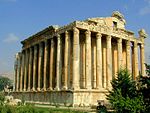
|
Beqaa Governorate, 34°0′25″N 36°12′18″E / 34.00694°N 36.20500°E |
Cultural: (i)(iv) |
— | 1984 | Baalbek, where a triad of deities was worshipped, was known as Heliopolis during the Hellenistic period. It kept its religious function during Roman times. Te sanctuary of the Heliopolitan Jupiter attracted thousands of pilgrims. | [17] |
| Bagrati Cathedral and Gelati Monastery | 
|
Imereti, 42°15′44″N 42°42′59″E / 42.26222°N 42.71639°E |
Cultural: (iv) |
7.87 (19.4) | 1994 | The site has been listed as endangered since 2010. A major reconstruction project that will lead to irreversible interventions and undermine the authenticity and integrity of the site. | [18] [19] |
| Bahá’i Holy Places in Haifa and the Western Galilee | 
|
Haifa and North District, 32°49′46″N 34°58′18″E / 32.82944°N 34.97167°E |
Cultural: (iii)(vi) |
63 (160); buffer zone 255 (630) | 2008 | [20] | |
| Bahla Fort | Ad Dakhiliyah Region, 22°57′51″N 57°18′4″E / 22.96417°N 57.30111°E |
Cultural: (iv) |
— | 1987 | The oasis of Bahla owes its richness to the Banu Nebhan, the dominant tribe in the area from the 12th to the end of the 15th century. The ruins of the large fort, with its walls and towers of unbaked brick and its stone foundations, is a remarkable example of this type of fortification. | [21] | |
| Bam and its Cultural Landscape | 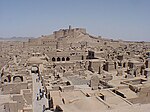
|
Kerman, 29°07′00.68″N 58°22′06.51″E / 29.1168556°N 58.3684750°E |
Cultural: (ii)(iii)(iv)(v) |
— | 2004 | The site has been listed as endangered since 2004 following the damage due to the 2003 Bam earthquake. | [22] [23] |
| Biblical Tels - Megiddo, Hazor, Beer Sheba | 
|
32°35′50″N 35°10′56″E / 32.59722°N 35.18222°E |
Cultural: (ii)(iii)(iv)(vi) |
96 (240); buffer zone 604 (1,490) | 2005 | [24] | |
| Bisotun | 
|
Kermanshah, 34°23′18″N 47°26′12″E / 34.38833°N 47.43667°E |
Cultural: (ii)(iii) |
187 (460); buffer zone 361 (890) | 2006 | [25] | |
| Byblos | 
|
Mount Lebanon Governorate, 34°7′9″N 35°38′51″E / 34.11917°N 35.64750°E |
Cultural: (iii)(iv)(vi) |
— | 1984 | The ruins of many civilizations are found at Byblos, one of the oldest Phoenician cities. People have live here since Neolithic times. It has been closely linked to the legends and history of the Mediterranean region for thousands of years. | [26] |
| Cathedral and Churches of Echmiatsin and the Archaeological Site of Zvartnots | 
|
Armavir Province, 40°9′33.5″N 44°17′42.5″E / 40.159306°N 44.295139°E |
Cultural: (ii)(iii) |
74 (180) | 2000 | [27] | |
| Choirokoitia | 
|
Larnaca District, 34°47′54″N 33°20′36″E / 34.79833°N 33.34333°E |
Cultural: (ii)(iii)(iv) |
— | 1998 | [28] | |
| City of Safranbolu | 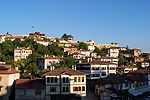
|
city and district of Safranbolu, Karabük Province, 41°15′36″N 32°41′23″E / 41.26000°N 32.68972°E |
Cultural: (ii)(iv)(v) |
193 (480) | 1994 | [29] | |
| Crac des Chevaliers and Qal’at Salah El-Din | 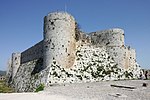
|
Homs and Latakia Governorates, 34°46′54″N 36°15′47″E / 34.78167°N 36.26306°E |
Cultural: (ii)(iv) |
9 (22) | 2006 | These two castles represent the most significant examples show the changes of fortified architecture in the Near East during the time of the Crusades (11th - 13th centuries). | [30] |
| Cultural Sites of Al Ain (Hafit, Hili, Bidaa Bint Saud and Oases Areas) | 
|
24°4′4″N 55°48′23″E / 24.06778°N 55.80639°E |
Cultural: (iii)(iv)(v) |
4,945 (12,220); buffer zone 7,605 (18,790) | 2011 | [31] | |
| Gobustan Rock Art Cultural Landscape | 
|
Garadagh and Absheron districts, 40°7′30″N 49°22′30″E / 40.12500°N 49.37500°E |
Cultural: (iii) |
537 (1,330); buffer zone 3,096 (7,650) | 2007 | [32] | |
| Great Mosque and Hospital of Divriği | 
|
city and district of Divriği, Sivas Province, 39°22′25″N 38°7′25″E / 39.37361°N 38.12361°E |
Cultural: (i)(iv) |
2,016 (4,980) | 1985 | [33] | |
| Göreme National Park and the Rock Sites of Cappadocia | 
|
Nevşehir Province in Central Anatolia Region, 38°40′0″N 34°51′0″E / 38.66667°N 34.85000°E |
Mixed: (i)(iii)(v)(vii) |
9,576 (23,660) | 1985 | [34] | |
| Hatra | 
|
Ninawa Governorate, 35°35′17″N 42°43′6″E / 35.58806°N 42.71833°E |
Cultural: (ii)(iii)(iv)(vi) |
324 (800) | 1985 | A large fortified city under the influence of the Parthian Empire and capital of the first Arab Kingdom, Hatra withstood invasions by the Romans in A.D. 116 and 198 thanks to its high, thick walls reinforced by towers. | [35] |
| Hattusha: the Hittite Capital | 
|
Sungurlu, Çorum Province, 40°0′50″N 34°37′14″E / 40.01389°N 34.62056°E |
Cultural: (i)(ii)(iii)(iv) |
268 (660) | 1986 | [36] | |
| Hierapolis-Pamukkale | 
|
Denizli Province, 37°55′26″N 29°7′24″E / 37.92389°N 29.12333°E |
Mixed: (iii)(iv)(vii) |
1,077 (2,660) | 1988 | [37] | |
| Historical Monuments of Mtskheta | 
|
Mtskheta-Mtianeti, 41°51′N 44°43′E / 41.850°N 44.717°E |
Cultural: (iii)(iv) |
— | 1994 | The site has been endangered since 2009. | [38] [39] |
| Historic Areas of Istanbul | 
|
Istanbul city and Istanbul Province, 41°0′30″N 28°58′48″E / 41.00833°N 28.98000°E |
Cultural: (i)(ii)(iii)(iv) |
678 (1,680) | 1985 | [40] | |
| Historic Town of Zabid | 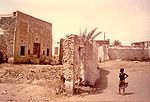
|
Al Hudaydah Governorate, 14°11′53″N 43°19′48″E / 14.19806°N 43.33000°E |
Cultural: (iii) |
— | 1993 | Zabid was the capital of Yemen from the 13th to the 15th century. The city played an important role in the Arab and Muslim world for many centuries because of its Islamic university. It has been listed as endangered since 2000. | [41] [42] |
| Incense Route – Desert Cities in the Negev | 
|
Negev, 30°32′28″N 35°9′39″E / 30.54111°N 35.16083°E |
Cultural: (iii)(v) |
— | 2005 | [43] | |
| Land of Frankincense | — | Dhofar Governorate, 18°15′12″N 53°38′51″E / 18.25333°N 53.64750°E |
Cultural: (iii)(iv) |
850 (2,100); buffer zone 1,243 (3,070) | 2000 | The frankincense trees of Wadi Dawkah and the remains of the caravan oasis and the ports of Khor Rori and Al-Baleed show the trade in frankincense that was strong in this region for many centuries. | [44] |
| Masada | 
|
South District, 31°18′49″N 35°21′10″E / 31.31361°N 35.35278°E |
Cultural: (iii)(iv)(vi) |
276 (680); buffer zone 28,965 (71,570) | 2001 | [45] | |
| Meidan Emam, Esfahan | Isfahan, 32°39′27″N 51°40′40″E / 32.65750°N 51.67778°E |
Cultural: (i)(v)(vi) |
— | 1979 | [46] | ||
| Monasteries of Haghpat and Sanahin | 
|
Haghpat and Sanahin, Lori Province, 41°5′42″N 44°42′37″E / 41.09500°N 44.71028°E |
Cultural: (ii)(iv) |
2.65 (6.5); buffer zone 24 (59) | 1996[nb 1] | [47] | |
| Monastery of Geghard and the Upper Azat Valley | 
|
near Goght, Kotayk Province, 40°9′32″N 44°47′48″E / 40.15889°N 44.79667°E |
Cultural: (ii) |
2.70 (6.7) | 2000 | [48] | |
| Nemrut Dağ | 
|
Adiyaman Province, 38°2′12″N 38°45′49″E / 38.03667°N 38.76361°E |
Cultural: (i)(iii)(iv) |
11 (27) | 1987 | [49] | |
| Old City of Acre | 
|
Western Galilee, 32°55′42″N 35°5′2″E / 32.92833°N 35.08389°E |
Cultural: (ii)(iii)(v) |
63 (160) | 2001 | [50] | |
| Old City of Sana'a | 
|
Sana'a Governorate, 15°21′20″N 44°12′29″E / 15.35556°N 44.20806°E |
Cultural: (iv)(v)(vi) |
— | 1986 | Sana’a has been lived in for more than 2,500 years. In the 7th and 8th centuries the city became a major centre for spreading Islam. This religious and political heritage can be seen in the 103 mosques, 14 hammams and over 6,000 houses, all built before the 11th century. | [51] |
| Old Walled City of Shibam | 
|
Hadhramaut Governorate, 15°55′37″N 48°37′36″E / 15.92694°N 48.62667°E |
Cultural: (iii)(iv)(v) |
— | 1982 | The 16th-century city of Shibam is one of the oldest and best examples of urban planning based on vertical construction. | [52] |
| Ouadi Qadisha (the Holy Valley) and the Forest of the Cedars of God (Horsh Arz el-Rab) | 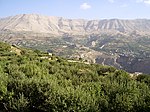
|
North Lebanon Governorate, 34°14′36″N 36°2′56″E / 34.24333°N 36.04889°E |
Cultural: (iii)(iv) |
— | 1998 | The Qadisha valley is one of the most important early Christian monastic settlements in the world. Nearby are the remains of the great forest of cedars of Lebanon, highly prized in antiquity for the construction of great religious buildings. | [53] |
| Painted Churches in the Troodos Region | Troodos Mountains, Limassol and Nicosia Districts, 34°55′13″N 33°5′45″E / 34.92028°N 33.09583°E |
Cultural: (iii)(vi) |
— | 1985[nb 2] | [54] [55] | ||
| Paphos | 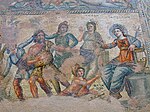
|
Paphos District, 34°45′30″N 32°24′20″E / 34.75833°N 32.40556°E |
Cultural: (iii)(vi) |
— | 1980 | [56] | |
| Pasargadae | 
|
Pars, 30°11′38″N 53°10′2″E / 30.19389°N 53.16722°E |
Cultural: (1)(ii)(iii)(iv) |
160 (400); buffer zone 7,127 (17,610) | 2004 | [57] | |
| Persepolis | 
|
Fars, 29°56′4″N 52°52′25″E / 29.93444°N 52.87361°E |
Cultural: (i)(iii)(vi) |
13 (32) | 1979 | [58] | |
| Petra | 
|
Ma'an Governorate, 30°19′50″N 35°26′36″E / 30.33056°N 35.44333°E |
Cultural: (i)(iii)(iv) |
— | 1985 | Lived in since prehistoric times, this Nabataean caravan-city, between the Red Sea and the Dead Sea, was an important crossroads between Arabia, Egypt and Syria-Phoenicia. Petra is half-built, half-carved into the rock, and is surrounded by mountains covered with passages and gorges. | [59] |
| Qal’at al-Bahrain – Ancient Harbour and Capital of Dilmun | Northern Governorate, 26°13′59″N 50°31′20″E / 26.23306°N 50.52222°E |
Cultural: (ii)(iii)(iv) |
32 (79); buffer zone 1,238 (3,060) | 2005[nb 3] | The site was the capital of the Dilmun, one of the most important ancient civilizations of the region. | [60] [61] | |
| Quseir Amra | 
|
Zarqa Governorate, 31°48′7″N 36°35′9″E / 31.80194°N 36.58583°E |
Cultural: (i)(iii)(iv) |
— | 1985 | Built in the early 8th century, this very well kept desert castle was both a fortress with a garrison and a residence of the Umayyad caliphs. | [62] |
| Samarra Archaeological City | Salah ad Din Governorate, 34°20′28″N 43°49′25″E / 34.34111°N 43.82361°E |
Cultural: (ii)(iii)(iv) |
15,058 (37,210); buffer zone 31,414 (77,630) | 2007 | Samarra Archaeological City is the site of a powerful Islamic capital city that ruled over the provinces of the Abbasid Empire extending from Tunisia to Central Asia for a century. The 9th-century Great Mosque and its spiral minaret are among the many remarkable architectural monuments of the site, 80% of which remain to be excavated. The site has been listed as endangered since it was added. | [63] [64] | |
| Selimiye Mosque and its Social Complex | 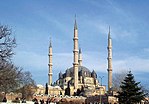
|
Edirne, East Thrace, 41°40′40″N 26°33′34″E / 41.67778°N 26.55944°E |
Cultural: (i)(iv) |
2.50 (6.2); buffer zone 38 (94) | 2011 | [65] | |
| Sheikh Safi al-din Khānegāh and Shrine Ensemble in Ardabil | 
|
Ardabil, Ardabil Province, 38°14′55″N 48°17′29″E / 38.24861°N 48.29139°E |
Cultural: (i)(ii)(iv) |
2.14 (5.3); buffer zone 13 (32) | 2010 | [66] | |
| Shushtar Historical Hydraulic System | 
|
Khuzestan, 32°1′7″N 48°50′9″E / 32.01861°N 48.83583°E |
Cultural: (i)(ii)(v) |
240 (590); buffer zone 1,572 (3,880) | 2009 | [67] | |
| Site of Palmyra | 
|
Homs Governorate, 34°33′15″N 38°16′0″E / 34.55417°N 38.26667°E |
Cultural: (i)(ii)(iv) |
0.36 (0.89) | 1980 | An oasis in the Syrian desert, north-east of Damascus, Palmyra has the monumental ruins of a great city that was one of the most important cultural centres of the ancient world. | [68] |
| Socotra Archipelago | 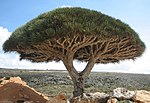
|
Hadhramaut Governorate, 12°30′N 53°50′E / 12.500°N 53.833°E |
Natural: (x) |
410,460 (1,014,300); buffer zone 1,740,958 (4,302,000) | 2008 | Socotra Archipelago, in the northwest Indian Ocean near the Gulf of Aden, is 250 km long. It has four islands and two rocky islets. The site is of universal importance because of its biodiversity with rich and distinct flora and fauna. | [69] |
| Soltaniyeh | — | Zanjan, 36°26′7″N 48°47′48″E / 36.43528°N 48.79667°E |
Cultural: (ii)(iii)(iv) |
790 (2,000); buffer zone 350 (860) | 2005 | [70] | |
| Tabriz Historic Bazaar Complex | 
|
Tabriz, 38°4′53″N 46°17′35″E / 38.08139°N 46.29306°E |
Cultural: (ii)(iii)(iv) |
29 (72); buffer zone 75 (190) | 2010 | [71] | |
| Takht-e Soleyman | 
|
West Azerbaijan, 36°36′14″N 47°14′6″E / 36.60389°N 47.23500°E |
Cultural: (i)(ii)(iii)(iv)(vi) |
10 (25); buffer zone 7,438 (18,380) | 2003 | [72] | |
| Tchogha Zanbil | 
|
Khuzestan, 32°5′0″N 48°32′0″E / 32.08333°N 48.53333°E |
Cultural: (iii)(iv) |
— | 1979 | [73] | |
| The Old City of Jerusalem and its Walls | 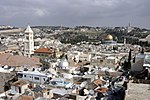
|
Jerusalem, 31°47′0″N 35°13′0″E / 31.78333°N 35.21667°E |
Cultural: (ii)(iii)(vi) |
— | 1981 | As a holy city for Judaism, Christianity and Islam, Jerusalem has always been of great symbolic importance. It is recognized by all three religions as the site of Abraham's sacrifice. The site has been listed as endangered since 1982. | [74] [75] [76] |
| The Persian Garden | 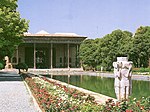
|
Pars, 30°10′0″N 53°10′0″E / 30.16667°N 53.16667°E |
Cultural: (i)(ii)(iii)(iv)(vi) |
716 (1,770); buffer zone 9,740 (24,100) | 2011 | [77] | |
| Tyre | 
|
South Lebanon Governorate, 33°16′19″N 35°11′40″E / 33.27194°N 35.19444°E |
Cultural: (iii)(vi) |
154 (380) | 1984 | Tyre ruled the seas and founded rich colonies such as Cadiz and Carthage. There are important archaeological remains, mainly from Roman times. | [78] |
| Um er-Rasas (Kastrom Mefa'a) | 
|
Madaba Governorate, 31°30′6″N 35°55′14″E / 31.50167°N 35.92056°E |
Cultural: (i)(iv)(vi) |
24 (59); buffer zone 90 (220) | 2005 | Most of this archaeological site, which started as a Roman military camp and grew to become a town from the 5th century, has not been excavated. It has remains from the Roman, Byzantine and Early Muslim periods (end of 3rd to 9th centuries AD) and a fortified Roman military camp. | [79] |
| Upper Svaneti | 
|
Chajashi, Mestia District, Samegrelo-Zemo Svaneti, 42°54′59″N 43°0′41″E / 42.91639°N 43.01139°E |
Cultural: (iv)(v) |
1.06 (2.6); buffer zone 19 (47) | 1996 | [80] | |
| Wadi Rum Protected Area | 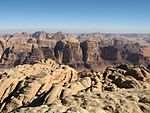
|
Aqaba Governorate, 29°38′N 35°26′E / 29.633°N 35.433°E |
Mixed: (iii)(v)(vii) |
74,180 (183,300); buffer zone 59,177 (146,230) | 2011 | The 74,000-hectare property is in southern Jordan, near the border with Saudi Arabia. It has a varied desert landscape, as well as 25,000 rock carvings with 20,000 inscriptions. | [81] |
| Walled City of Baku with the Shirvanshah's Palace and Maiden Tower | 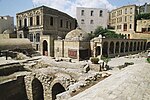
|
Absheron Peninsula, 40°22′0″N 49°50′0″E / 40.36667°N 49.83333°E |
Cultural: (iv) |
22 (54) | 2000 | [82] | |
| White City of Tel-Aviv -- the Modern Movement | 
|
Tel Aviv, 32°4′0″N 34°47′0″E / 32.06667°N 34.78333°E |
Cultural: (ii)(iv) |
140 (350); buffer zone 197 (490) | 2003 | [83] | |
| Xanthos-Letoon | 
|
, Muğla and Antalya Provinces, 36°20′6″N 29°19′13″E / 36.33500°N 29.32028°E |
Cultural: (ii)(iii) |
126 (310); buffer zone 63 (160) | 1988 | [84] |
- Notes
- ↑ Extended in 2000 to include the Sanahin Monastery and name change from Monastery of Haghpat to the present name.
- ↑ Extended in 2001 to include the church Metamorfosis tou Sotiros (Transfiguration of the Saviour) in Palaichori.
- ↑ Minor modification of the core zone and enlargement of the buffer zone in 2008.
References[change | change source]
- ↑ "Number of World Heritage Properties by region". UNESCO. Retrieved 10 September 2011.
- ↑ "Composition of macro geographical (continental) regions, geographical sub-regions, and selected economic and other groupings". Geographical region and composition of each region. United Nations Statistics Division. 2010. Retrieved 20 October 2011.
- ↑ 3.0 3.1 "World Heritage List". UNESCO. Retrieved 28 May 2010.
- ↑ "Aflaj Irrigation Systems of Oman". UNESCO. Retrieved 17 Aug 2011.
- ↑ "Al-Hijr Archaeological Site (Madâin Sâlih)". UNESCO. Retrieved 17 Aug 2011.
- ↑ "Ancient City of Aleppo". UNESCO. Retrieved 17 Aug 2011.
- ↑ "Ancient City of Bosra". UNESCO. Retrieved 17 Aug 2011.
- ↑ "Ancient City of Damascus". UNESCO. Retrieved 17 Aug 2011.
- ↑ "Ancient Villages of Northern Syria". UNESCO. Retrieved 17 Aug 2011.
- ↑ "Anjar". UNESCO. Retrieved 17 Aug 2011.
- ↑ "Archaeological Site of Troy". UNESCO. Retrieved 7 Dec 2011.
- ↑ "Archaeological Sites of Bat, Al-Khutm and Al-Ayn". UNESCO. Retrieved 17 Aug 2011.
- ↑ "Armenian Monastic Ensembles of Iran". UNESCO. Retrieved 3 December 2010.
- ↑ "Ashur (Qal'at Sherqat)". UNESCO. Retrieved 17 Aug 2011.
- ↑ 27th session 2003, pp. 123–124
- ↑ "At-Turaif District in ad-Dir'iyah". UNESCO. Retrieved 17 Aug 2011.
- ↑ "Baalbek". UNESCO. Retrieved 17 Aug 2011.
- ↑ "Bagrati Cathedral and Gelati Monastery". UNESCO. Retrieved 3 December 2010.
- ↑ 34th session 2010, pp. 130–133
- ↑ "Bahá'i Holy Places in Haifa and the Western Galilee". UNESCO. Retrieved 17 Aug 2011.
- ↑ "Bahla Fort". UNESCO. Retrieved 17 Aug 2011.
- ↑ "Bam and its Cultural Landscape". UNESCO. Retrieved 3 December 2010.
- ↑ 28th session 2004, pp. 47–48
- ↑ "Biblical Tels - Megiddo, Hazor, Beer Sheba". UNESCO. Retrieved 17 Aug 2011.
- ↑ "Bisotun". UNESCO. Retrieved 3 December 2010.
- ↑ "Byblos". UNESCO. Retrieved 17 Aug 2011.
- ↑ "Cathedral and Churches of Echmiatsin and the Archaeological Site of Zvartnots". UNESCO. Retrieved 17 Aug 2011.
- ↑ "Choirokoitia". UNESCO. Retrieved 17 Aug 2011.
- ↑ "City of Safranbolu". UNESCO. Retrieved 7 Dec 2011.
- ↑ "Crac des Chevaliers and Qal'at Salah El-Din". UNESCO. Retrieved 17 Aug 2011.
- ↑ "Cultural Sites of Al Ain (Hafit, Hili, Bidaa Bint Saud and Oases Areas)". UNESCO. Retrieved 10 Dec 2011.
- ↑ "Gobustan Rock Art Cultural Landscape". UNESCO. Retrieved 10 Dec 2011.
- ↑ "Great Mosque and Hospital of Divriği". UNESCO. Retrieved 7 Dec 2011.
- ↑ "Göreme National Park and the Rock Sites of Cappadocia". UNESCO. Retrieved 7 Dec 2011.
- ↑ "Hatra". UNESCO. Retrieved 17 Aug 2011.
- ↑ "Hattusha: the Hittite Capital". UNESCO. Retrieved 7 Dec 2011.
- ↑ "Hierapolis-Pamukkale". UNESCO. Retrieved 7 Dec 2011.
- ↑ "Historical Monuments of Mtskheta". UNESCO. Retrieved 3 December 2010.
- ↑ 33rd session 2009, p. 139
- ↑ "Historic Areas of Istanbul". UNESCO. Retrieved 7 Dec 2011.
- ↑ "Historic Town of Zabid". UNESCO. Retrieved 17 Aug 2011.
- ↑ 24th session 2000, pp. 26–27
- ↑ "Incense Route – Desert Cities in the Negev". UNESCO. Retrieved 17 Aug 2011.
- ↑ "Land of Frankincense". UNESCO. Retrieved 17 Aug 2011.
- ↑ "Masada". UNESCO. Retrieved 17 Aug 2011.
- ↑ "Meidan Emam, Esfahan". UNESCO. Retrieved 3 December 2010.
- ↑ "Monasteries of Haghpat and Sanahin". UNESCO. Retrieved 17 Aug 2011.
- ↑ "Monastery of Geghard and the Upper Azat Valley". UNESCO. Retrieved 17 Aug 2011.
- ↑ "Nemrut Dağ". UNESCO. Retrieved 7 Dec 2011.
- ↑ "Old City of Acre". UNESCO. Retrieved 17 Aug 2011.
- ↑ "Old City of Sana'a". UNESCO. Retrieved 17 Aug 2011.
- ↑ "Old Walled City of Shibam". UNESCO. Retrieved 17 Aug 2011.
- ↑ "Ouadi Qadisha (the Holy Valley) and the Forest of the Cedars of God (Horsh Arz el-Rab)". UNESCO. Retrieved 17 Aug 2011.
- ↑ "Painted Churches in the Troodos Region". UNESCO. Retrieved 17 Aug 2011.
- ↑ "Decision - 25COM X.B - Painted Churches in the Troodos Region [Extension to include the Church of Ayia Sotira, Palaichori] (Cyprus)". UNESCO. Retrieved 17 Aug 2011.
- ↑ "Paphos". UNESCO. Retrieved 17 Aug 2011.
- ↑ "Pasargadae". UNESCO. Retrieved 3 December 2010.
- ↑ "Persepolis". UNESCO. Retrieved 3 December 2010.
- ↑ "Petra". UNESCO. Retrieved 17 Aug 2011.
- ↑ "Qal'at al-Bahrain – Ancient Harbour and Capital of Dilmun". UNESCO. Retrieved 17 Aug 2011.
- ↑ "Evaluatinos of Cultural Properties: 32nd ordinary session" (PDF). UNESCO. p. 37. Retrieved 17 Aug 2011.
- ↑ "Quseir Amra". UNESCO. Retrieved 17 Aug 2011.
- ↑ "Samarra Archaeological City". UNESCO. Retrieved 17 Aug 2011.
- ↑ 31st session 2007, pp. 152–153
- ↑ "Selimiye Mosque and its Social Complex". UNESCO. Retrieved 7 Dec 2011.
- ↑ "Sheikh Safi al-din Khānegāh and Shrine Ensemble in Ardabil". UNESCO. Retrieved 3 December 2010.
- ↑ "Shushtar Historical Hydraulic System". UNESCO. Retrieved 3 December 2010.
- ↑ "Site of Palmyra". UNESCO. Retrieved 17 Aug 2011.
- ↑ "Socotra Archipelago". UNESCO. Retrieved 17 Aug 2011.
- ↑ "Soltaniyeh". UNESCO. Retrieved 3 December 2010.
- ↑ "Tabriz Historic Bazaar Complex". UNESCO. Retrieved 3 December 2010.
- ↑ "Takht-e Soleyman". UNESCO. Retrieved 3 December 2010.
- ↑ "Tchogha Zanbil". UNESCO. Retrieved 3 December 2010.
- ↑ "Old City of Jerusalem and its Walls". UNESCO. Retrieved 17 Aug 2011.
- ↑ "World Heritage Committee: Sixth session" (PDF). UNESCO. pp. 10–12. Retrieved 26 June 2011.
- ↑ "UNESCO replies to allegations". UNESCO. 15 July 2011. Retrieved 20 October 2011.
- ↑ "The Persian Garden". UNESCO. Retrieved 3 December 2011.
- ↑ "Tyre". UNESCO. Retrieved 17 Aug 2011.
- ↑ "Um er-Rasas (Kastrom Mefa'a)". UNESCO. Retrieved 17 Aug 2011.
- ↑ "Upper Svaneti". UNESCO. Retrieved 17 Aug 2011.
- ↑ "Wadi Rum Protected Area". UNESCO. Retrieved 17 Aug 2011.
- ↑ "Walled City of Baku with the Shirvanshah's Palace and Maiden Tower". UNESCO. Retrieved 10 Dec 2011.
- ↑ "White City of Tel-Aviv -- the Modern Movement". UNESCO. Retrieved 17 Aug 2011.
- ↑ "Xanthos-Letoon". UNESCO. Retrieved 7 Dec 2011.


